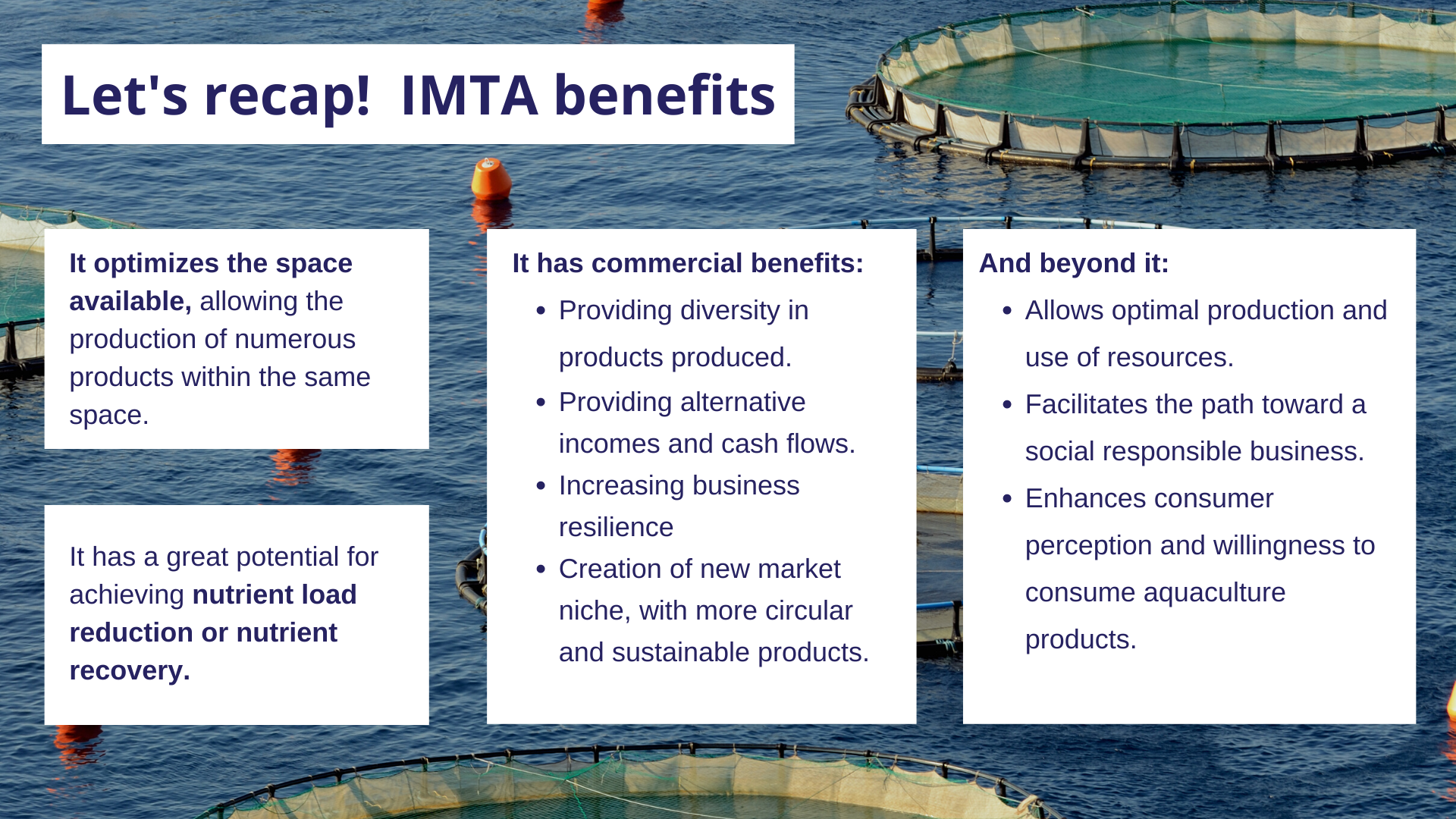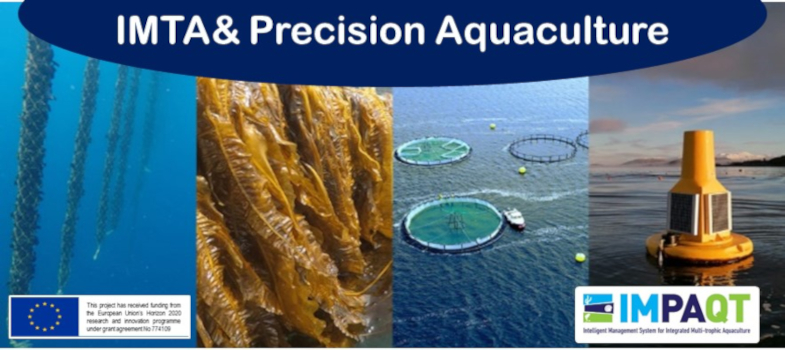The benefits and challenges to IMTA
The benefits and challenges to IMTA
Integrated Multi-trophic aqaculture (IMTA) offers a new concept in aquaculture. It brings aquaculture from single species farming to multi-species, complementary, and integrated farming. And this brings many benefits with it.
Changing from the linear production model of farming to a more circular, whole eco-system approach is a key benefit. Farming fed species such as fish involves adding to the ecosystem fish feed, to grow the fish. The major inputs to the ecosystem from fed aquaculture are the faeces and any uneaten food — or particulate waste, dissolved waste, and organic food waste. These can be generally characterized as nitrogenous waste (Nitrogen [N] in the form of ammonia and ammonia ions [NH3 and NH4+]), phosphorous waste (Phosphorus [P] in the form of phosphate [PO43-]), and waste carbon.

In the linear model, the food is fed to the fish and the fish waste is released for dilution in the environment. IMTA makes use of this product to serve as a food source for other farmed species, thus reducing waste and reusing the nutrients in another commercial product — such as shellfish and or seaweed.
IMTA replaces the dilution of waste principle with extraction and the conversion of these excess nutrients and energy into other commercial crops. The farm copies the natural cycles in the ecosystem and allows the reuse of nutrients, reducing waste and environmental impacts. IMTA provides a waste reduction service to the industry. This bioremediation element can contribute to meeting regulations and discharge limits, e.g. cleaning the water on the site so it can be discharged pristine, or to be reused.
To increase circularity, the seaweed, plants or other species grown could be used as an ingredient in the fish food, creating a full circular system. This form of IMTA reduces the ecological impacts near the aquaculture operation while providing additional useful products. This reduction in ecological impacts and circularity is desirable from both a regulator and a consumer point of view, so IMTA can have the advantage of improving the societal perception of aquaculture.
This model can mean that IMTA grown products have an advantage in the marketplace by being more friendly to the environment, as well as making aquaculture a more acceptable activity amongst the general public, and politically. IMTA helps to decouple economic growth from resource use by reducing the volume of wasted resources and utilising by-products. Different IMTA models can bring different societal and community benefits – such as with the lobster stocking described in later modules.
IMTA also allows for the optimisation of the space available. It allows for numerous products to be produced within the same space, utilising the resource more effectively and efficiently.
There is a commercial benefit to the farmer by growing other products on their site. Diversity provides alternative incomes and cash flows, increasing the resilience of the business. IMTA products provide a new market niche, of more circular and environmentally sustainable products, which could command a premium price.Nonetheless, while the IMTA concept has many advantages, it has not yet been adapted on any scale across Europe. The bottle necks to this are largely economic and regulatory.
There is generally an imbalance between income from the fish produced compared to the other trophic layers – the shellfish, invertebrates, and seaweed or plants which are generally lower market value – and this can discourage the adaption of the concept. Adding other trophic levels in an IMTA set-up adds complexity to the farm, it increases costs and effort on the farmers.
Farmers are familiar with their current systems and change is always a risk, and new skills need to be acquired. But as more and more begin to adapt IMTA practises and the expertise and technologies improve, this barrier will become less. The simple model of a single farmer producing multiple species can be expanded, farmers could look at working with other farmers or with cooperatives locally. The fish may be farmed by one company, whereas the shellfish, seaweed, or other species could be cared for by others, with mutually beneficial arrangements put in place to ensure optimal production and use of resources. This model would require innovative regulatory oversight.
Anyway, while IMTA provides income and an alternative revenue stream, the economic element may not be the key reason for farms to adapt. There is an intrinsic benefit in being more sustainable and reducing your environmental impact, along with it offering
desirable societal and regulatory benefits. These non-economic motivators can be powerful in a socially minded business environment, where corporate social responsibility is emphasised.
A good example of how IMTA is more sustainable is the inclusion of seaweed among the species farmed. Seaweeds remove nutrients (nitrogen, phosphorous, and carbon), and can be farmed without fertilizer in an IMTA system. As seaweeds are farmed in the water, there is no demand for scarce land and water resources. Moreover, seaweeds provide oxygen to the water column when photosynthesising. They 'sequester' carbon thus slowing down global warming and reducing coastal acidification, but the carbon sequestration is short-term as the seaweed is used and the carbon is released again.
Another key point is that ocean-based proteins are substantially less carbon-intensive than land-based proteins (especially beef and lamb). Therefore, actions that shift diets to lower carbon protein, including ocean-based proteins, help
to reduce emissions.
To achieve more sustainability, the regulators must also have the vision to look at new methods of regulation, and facilitate these more complex but more sustainable practises. Licences must facilitate multi-species at a site, the interactivity between species, and allow the flexibility to farm the different species collectively. The ability for multiple operators to farm on the same location would have to be considered.
Regulation must consider the ecosystem beyond the specific farm site, as waste and nutrients are not confined within the coordinates of a licensed site. A more ecosystem-based management approach is needed, and on the value and ecosystem services that the different species offer within the ecosystem.
The IMTA concept works on the bay or management area level and regulation must be able to facilitate this. Integration should be understood as cultivation in proximity, meaning not just absolute distances between species but connectivity in terms of ecosystem functionalities. The 'integrated' element involves to connectivity within water bodies, rather than within absolute distances or spaces. The IMTA concept can be extended within very large ecosystems.

This leads to ideas like nutrient trading, which could be explored through IMTA – this can be used to push nutrient load reduction or nutrient recovery. The concept of nitrogen credits or carbon credits for IMTA production could be explored. An IMTA set-up with the appropriate species can be used to reduce the overall nitrogenous, carbon, or phosphorous levels. Regulation needs to consider the values of the services to society provided by removing these minerals, versus water treatment.
The move to IMTA will be a slow process as people learn the processes and technologies. Having multiple products is useful, it gives product diversity and creates a second revenue stream, but the value of IMTA is more than commercial, the ecosystem services provided are a significant benefit from the system. As mentioned before, IMTA reduces the environmental impact, increases sustainability and circularity in the economy processes, and it uses the space more efficiently. This gives a boost to consumer perception of the products, and in the societal and the political license to operate. These are key benefits to the aquaculture sector in general.


Ecosystem Services of Aquaculture
Aquaculture increasingly sits within complex global value chains, while ecological impacts at the production site are only part of the total ecological interaction, which includes everything from farming and processing to human consumption and the disposal or recycling of wastes that causes. The FAO of the United Nations has identified the need for an Ecosystem approach to aquaculture.
An ecosystem approach to aquaculture (EAA) is a strategy for the integration of the activity within the wider ecosystem such that it promotes sustainable development, equity, and resilience of interlinked social-ecological systems.
FAO has also highlighted the importance of stakeholder participation, the need for a precautionary and adaptive approach given the high complexity of these systems, the ability of waste products from one activity or sector to serve as inputs to another, as well as the need for broader social, economic and environmental considerations.
Ecosystem services are defined as all benefits that people obtain from ecosystems. Generally, four categories are distinguished.
- Supporting services are necessary for the production of all other ecosystem services.
- Provisioning services comprise products that can be obtained from the ecosystem.
- Regulating services represent benefits obtained from the regulation of ecosystem processes.
- Cultural services are the nonmaterial benefits that people obtain from ecosystems e.g. spiritual enrichment, cognitive development, aesthetic experiences, etc.
Extractive aquaculture performs very important regulating services. Seaweed and shellfish take up nutrients from the water column. Particularly in areas impacted by eutrophication, the removal of nutrients is valuable for general water quality. In areas where the extension of fish farming is restricted because of nutrient input, extractive aquaculture can provide the space in terms of nutrient budget for extension. Conversely in oligotrophic areas, where mussel and seaweed production is limited by nutrient availability, nearby fish farms may boost production. In that situation, the fish farms are providing a supporting service for extractive aquaculture.
Another supporting service that aquaculture can provide is shelter and habitat for other species in the ecosystem. E.g. locating oyster restoration projects close to or underneath aquaculture sites, may offer possibilities as trawling is generally not possible in sites dedicated to aquaculture.
Which service is most relevant depends strongly on the status of the environment. It is often very difficult to put a direct monetary value on ecosystem services, other than provisioning ones. However, it is important to assess other services, and where appropriate, devise methods to incorporate their value into business cases. Ultimately, making optimal use of the various ecosystem services will ensure optimal use of natural resources within ecosystems as well as optimal benefits to farmers, society as a whole, and the natural environment.
